- Scientific name: Panicum philadelphicum Bernh. ex Nees
- Synonymy: Panicum philadelphicum ssp. philadelphicum, Panicum gattingeri Nash., Panicum philadelphicum ssp. gattingeri, Panicum philadelphicum var. campestre
- Species of Greatest Conservation Need (MA State Wildlife Action Plan)
- Special Concern (MA Endangered Species Act)
Description
Philadelphia panic-grass (Panicum philadelphicum), a member of the grass family (Poaceae), is a slender, hairy, herbaceous, annual grass with yellow-green leaves that grows from a bundle of fibrous roots. It can grow to a height of about 80-100 cm (2.5–3.25 ft) but can also be found as tiny plants on receding pond shores only 2-5 cm (1-2 in) tall. Philadelphia panic-grass consists of three subspecies, two of which occur in Massachusetts (both rare here): Philadelphia panic-grass (P. philadelphicum ssp. philadelphicum) and Gattinger’s panic-grass (P. philadelphicum ssp. gattingeri [now considered as P. gattingeri in several keys]).
Members of the genus Panicum are difficult to distinguish from one another and at first glance may appear similar. There are nine species of Panicum documented in Massachusetts. Some species previously included in Panicum are now in a related genus, Coleataenia, which is still referred to as “panic-grass.” To positively identify any member of Panicum (including P. philadelphicum and its subspecies), a technical manual and access to flowering material is required to differentiate them from each other and from other related members of Poaceae. The basic flowering unit of grasses is the spikelet, which may or may not have a pair of bracts at its base called glumes. A spikelet may be made up of one-to-many individual flowers (florets). Each floret has a pair of bracts at its base called the lemma and the palea. The palea is closer to the stem of the spikelet (rachilla) than the lemma. Species in the genus Panicum produce inflorescences on the ends of their stems (rachis) in an open panicle and have spikelets with more than one floret. The spikelets have thin membranous glumes, a lower, sterile or male floret with a lemma that resembles the glumes, and an upper, fertile floret with a rigid, shiny lemma that clasps the palea and the seed.
Philadelphia panic-grass has branching, hairy stems that are erect to decumbent (curving at the base with an ascending tip).
| Characteristics | ssp. philadelphicum | ssp. gattingeri |
|---|---|---|
| Spikelet length | 1.4 – 2.1 mm (0.06 – 0.08 in) | 1.9 – 2.4 mm (0.07 – 0.09 in) |
| Flag leaf length | less than half the length of panicle | greater than half the length of panicle |
| Secondary panicle branches and floral stalks | press against the primary panicle branches | diverge away from the main panicle branches |
| Upper glume and lower lemma tips | curve over the upper flowers | straight |
| Leaf blade width | usually 2–6 mm (0.08 – 0.24 in) | 5–12 mm (0.20 – 0.47 in) |
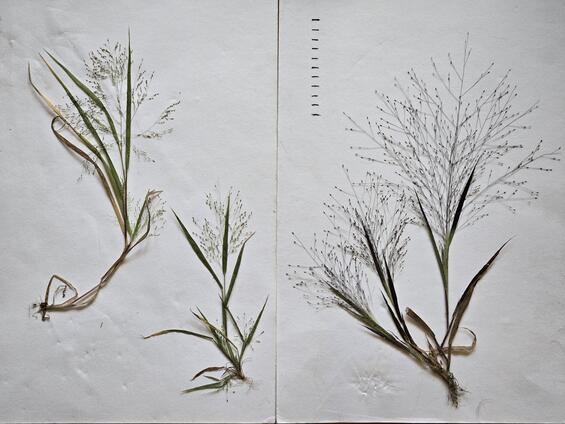
A comparison of three Panicum section Capillare species. From left to right: Panicum tuckermanii, Panicum philadelphicum ssp. gattingeri, Panicum capillare. The scale is in centimeters. Photo credit: Matt Charpentier
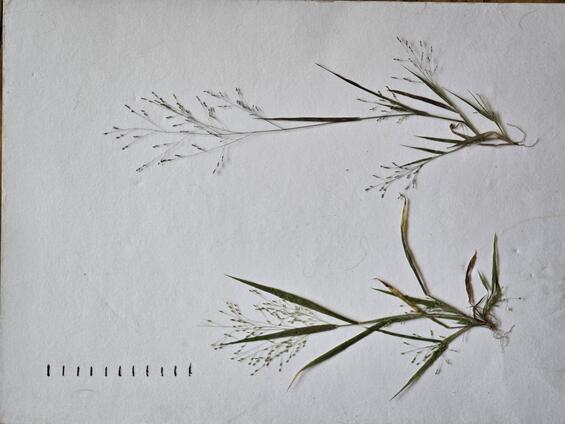
A comparison of the two subspecies of Panicum philadelphicum. Upper image: Panicum philadelphicum ssp. gattingeri, note the relatively longer flag leaf compared to the inflorescence length. Lower image: Panicum philadelphicum ssp. philadelphicum, note the relatively shorter flag leaf compared to the inflorescence length. The scale is in centimeters. Photo credit: Matt Charpentier
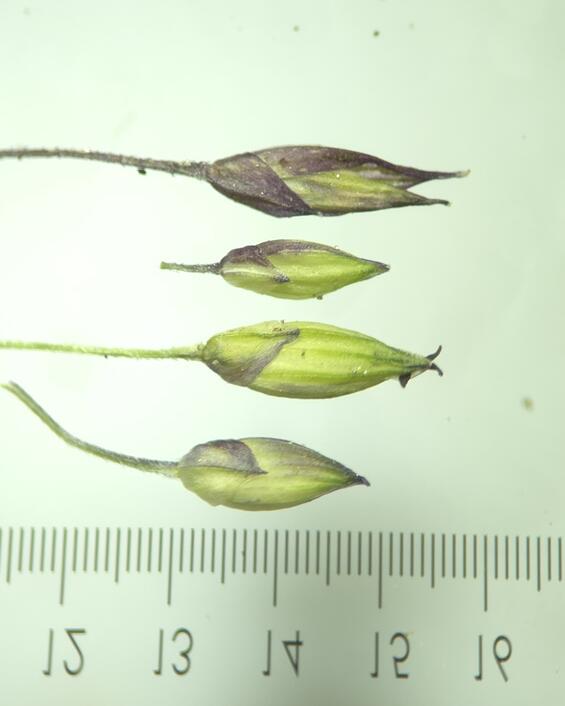
A comparison of spikelets. The left image depicts spikelets with the second glume face up, and the right image depicts spikelets with the first glume and first lemma face up. From top to bottom: Panicum philadelphicum ssp. philadelphicum, Panicum philadelphicum ssp. gattingeri, Panicum tuckermanii, and Panicum capillare. The scale is in millimeters. Photo credit: Matt Charpentier
Life cycle and behavior
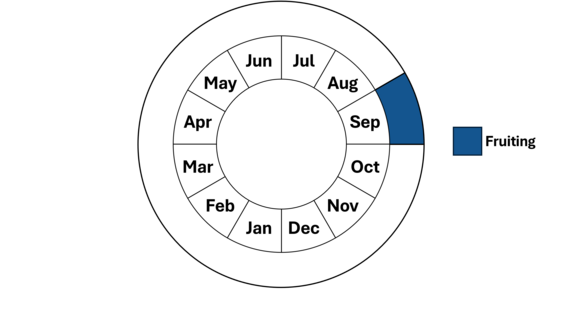
Population status
Both subspecies of Philadelphia panic-grass are listed under the Massachusetts Endangered Species Act as a species of Special Concern. All listed species are legally protected from killing, collection, possession, or sale, and from activities that would destroy habitat and thus directly or indirectly cause mortality or disrupt critical behaviors.
Panicum philadelphicum ssp. philadelphicum has 13 populations verified since 1999 known from Bristol, Franklin, Hampden, Middlesex, Plymouth, and Worcester Counties. Panicum philadelphicum ssp. gattingeri has been verified in Berkshire and Dukes Counties since 1999. Both may occur elsewhere in the state but are easily overlooked due to their similarity to other Panicum species.
Distribution and abundance
Subspecies philadelphicum ranges from Nova Scotia west to Ontario and south to Georgia, Alabama, and Texas. It is not considered globally imperiled, but is rare in several states including Rhode Island, Ohio, and Iowa. Subspecies gattingeri ranges from Quebec and Ontario south to North Carolina, Oklahoma, Kansas, and Alabama, and is similarly rare in multiple states including New Jersey and Kansas. Neither is considered globally imperiled.
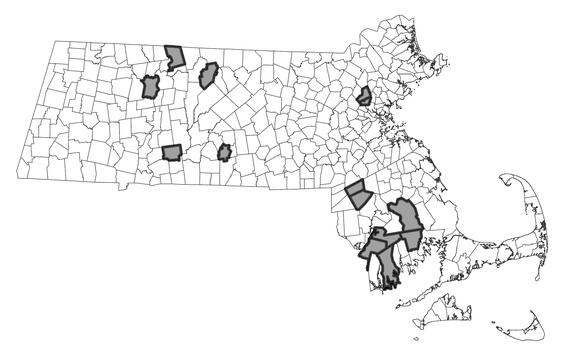
Panicum philadelphicum ssp. philadelphicum. Distribution in Massachusetts. 1999-2024. Based on records in the Natural Heritage Database.
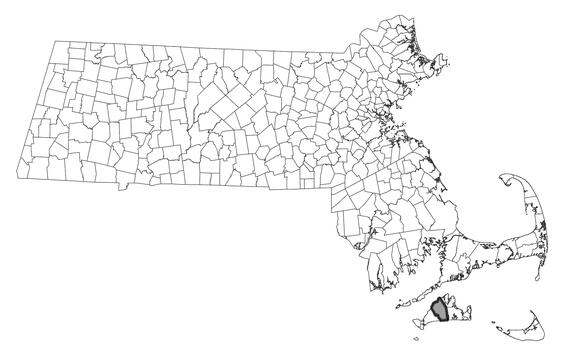
Panicum philadelphicum ssp. gattingeri. Distribution in Massachusetts. 1999-2024. Based on records in the Natural Heritage Database.
Habitat
Subspecies philadelphicum grows in open, full sun, on seasonally flooded sands typically bordering acidic streams, lakes, and wetlands. Plants typically found growing in association with it in Massachusetts include: common buttonbush (Cephalanthus occidentalis), golden hedge-hyssop (Gratiola aurea), fall panic-grass (P. dichotomiflorum), slender fimbry (Fimbristylis autumnalis), toothed flatsedge (Cyperus dentatus), and various spikerushes (Eleocharis spp.).
Subspecies gattingeri grows in open, disturbed areas, usually with alkaline soils. All but one documented occurrence in Massachusetts is found along roadsides; the other is on a cliff top. Associated species include: field horsetail (Equisetum arvense), ragweed (Ambrosia artemisiifolia), and witchgrass (P. capillare).
Healthy habitats are vital for supporting native wildlife and plants. Explore habitats and learn about conservation and restoration in Massachusetts.
Threats
Subspecies philadelphicum requires open, sunny habitat that experiences seasonal flooding. Activities that alter hydrologic regimes or encourage overgrowth and shading by succession can be threats. One population of subspecies gattingeri occurs near a roadside and is vulnerable to road maintenance activities. Roads also serve as corridors for invasive plant species that form dense monocultures and exclude natives. Preventing their spread is critical.
Conservation
Surveys for both Panicum philadelphicum subspecies should occur late in the season, when the species are in bloom or in fruit (late August into October). More than one survey may be needed to determine the species presence, as an area that is inundated in August, may allow for germination of the species and flowering as water levels recede. As a grass, both subspecies are likely under surveyed.
The management needs of Panicum philadelphicum are not fully understood. As an annual species that is an early colonizer of damp to wet openings on sunny sandy soil, it is expected that it will be found new locations as the habitats change around it. Neither subspecies is a strong competitor against taller vegetation. To avoid inadvertent harm to rare plants, all active management (including invasive species removal) should be planned in consultation with MassWildlife’s Natural Heritage & Endangered Species Program.
There has been substantial research in section Panicum. The technical keys are starting to catch up with the changes in the names. However, research in Massachusetts is needed to determine causes of decline, and conditions needed for species to be relocated. Research is needed to determine whether this plant can be grown in a nursery or garden setting for purposes of generating sufficient seed to expand populations. If habitat degradation accelerates losses of current populations, this strategy could prove useful to long-term conservation of this species.
References
Darbyshire, S.J. and J. Cayouette. 1995. Identification of the species in the Panicum capillare complex (Poaceae) from eastern Canada and adjacent New York State. Canadian Journal of Botany 73: 333-348.
Freckmann, R.W., and M.G. LeLong. 2003. Panicum. Pages 450-488 in Flora of North America Editorial Committee and M.E. Barkworth, K.M Capels. S. Long, and M.B. Piep, editors. Flora of North America, volume 25. Oxford University Press. New York, NY.
Gleason, H.A. and A. Cronquist. 1991. Manual of Vascular Plants of Northeastern United States and Adjacent Canada, Second Edition. The New York Botanical Garden, Bronx, New York.
Haines, A. 2011. Flora Novae Angliae. The New England Wild Flower Society. Yale University Press, New Haven, CT.
NatureServe. 2025. NatureServe Network Biodiversity Location Data accessed through NatureServe Explorer [web application]. NatureServe, Arlington, Virginia. Available https://explorer.natureserve.org/. Accessed: 4/29/2025.
POWO (2025). Plants of the World Online. Facilitated by the Royal Botanic Gardens, Kew. Published on the Internet; https://powo.science.kew.org/ Accessed: 4/29/2025.
Weakley, A.S. 2020. Flora of the southeastern United States. University of North Carolina Herbarium, North Carolina Botanical Garden, Chapel Hill, NC.
Acknowledgement
MassWildlife acknowledges the expertise of Matt Charpentier, who contributed substantially to the development of this fact sheet.
Contact
| Date published: | May 1, 2025 |
|---|